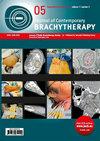乳腺癌间质近距离治疗术后植入与术中植入:如何选择?
IF 1.1
4区 医学
Q4 ONCOLOGY
引用次数: 0
摘要
目的:乳腺近距离放射治疗(BB)是现代乳腺癌治疗中的一种重要放射治疗方式。目前,乳腺近距离放射治疗主要用于加速乳腺部分照射(APBI)、全乳腺放射治疗(WBRT)后的局部增量以及第二次肿块切除术后的挽救性再照射(APBrl)。可提供两种多导管间质近距离放射治疗(MIB)技术:术中(IOB)和术后(POB)近距离放射治疗。本文旨在总结这两种不同的乳腺癌近距离治疗方法的现有数据。材料和方法:我们进行了文献检索,并对 BB 专家团队发表的不同经验进行了分析和比较。在 GEC-ESTRO BCWG 会议上也介绍并讨论了这两种不同的乳腺癌近距离治疗方法。结果:考虑到最新发表的数据,对这两种技术(即 IOB 和 POB)进行了全面描述和实际比较。对两种方法的不同技术、后勤和临床方面进行了深入的研究和分析。结论:基于对两种近距离放射治疗技术的全面分析,这篇文章是指导乳腺团队选择最佳近距离放射治疗技术(POB 或 IOB)的宝贵资源,同时考虑到了医院环境、多学科协作和患者后勤保障。本文章由计算机程序翻译,如有差异,请以英文原文为准。
Post- versus intra-operative implant for breast cancer interstitial brachytherapy: How to choose?
Purpose:
Breast brachytherapy (BB) represents an important radiation therapy modality in modern breast cancer treatments. Currently, BB is mainly used for accelerated partial breast irradiation (APBI), local boost after whole breast radiation therapy (WBRT), and as salvage re-irradiation after second lumpectomy (APBrl). Two multi-catheter interstitial brachytherapy (MIB) techniques can be offered: intra-operative (IOB) and post-operative (POB) brachytherapy. The aim of this article was to summarize current available data on these two different brachytherapy approaches for breast cancer.
Material and methods:
A literature search was performed, and different experiences published by BB expert teams were analyzed and compared. These two different brachytherapy approaches for breast cancer have also been presented and discussed during meetings of the GEC-ESTRO BCWG. In addition, expert recommendations were defined.
Results:
A comprehensive description and practical comparison of both the techniques, i.e., IOB and POB, considering the latest available published data were presented. Different technical, logistic, and clinical aspects of both the methods were thoroughly examined and analyzed. This detailed comparison of the two breast brachytherapy techniques was supported by scientific data from extensive experience of experts, facilitating an objective analysis that, to our knowledge, has not been previously published.
Conclusions:
Based on the comprehensive analysis of both the brachytherapy techniques available, this article serves as a valuable resource to guide breast teams in selecting the optimal BB technique (POB or IOB), considering hospital environment, multi-disciplinary collaboration, and patient logistics.
Breast brachytherapy (BB) represents an important radiation therapy modality in modern breast cancer treatments. Currently, BB is mainly used for accelerated partial breast irradiation (APBI), local boost after whole breast radiation therapy (WBRT), and as salvage re-irradiation after second lumpectomy (APBrl). Two multi-catheter interstitial brachytherapy (MIB) techniques can be offered: intra-operative (IOB) and post-operative (POB) brachytherapy. The aim of this article was to summarize current available data on these two different brachytherapy approaches for breast cancer.
Material and methods:
A literature search was performed, and different experiences published by BB expert teams were analyzed and compared. These two different brachytherapy approaches for breast cancer have also been presented and discussed during meetings of the GEC-ESTRO BCWG. In addition, expert recommendations were defined.
Results:
A comprehensive description and practical comparison of both the techniques, i.e., IOB and POB, considering the latest available published data were presented. Different technical, logistic, and clinical aspects of both the methods were thoroughly examined and analyzed. This detailed comparison of the two breast brachytherapy techniques was supported by scientific data from extensive experience of experts, facilitating an objective analysis that, to our knowledge, has not been previously published.
Conclusions:
Based on the comprehensive analysis of both the brachytherapy techniques available, this article serves as a valuable resource to guide breast teams in selecting the optimal BB technique (POB or IOB), considering hospital environment, multi-disciplinary collaboration, and patient logistics.
求助全文
通过发布文献求助,成功后即可免费获取论文全文。
去求助
来源期刊

Journal of Contemporary Brachytherapy
ONCOLOGY-RADIOLOGY, NUCLEAR MEDICINE & MEDICAL IMAGING
CiteScore
2.40
自引率
14.30%
发文量
54
审稿时长
16 weeks
期刊介绍:
The “Journal of Contemporary Brachytherapy” is an international and multidisciplinary journal that will publish papers of original research as well as reviews of articles. Main subjects of the journal include: clinical brachytherapy, combined modality treatment, advances in radiobiology, hyperthermia and tumour biology, as well as physical aspects relevant to brachytherapy, particularly in the field of imaging, dosimetry and radiation therapy planning. Original contributions will include experimental studies of combined modality treatment, tumor sensitization and normal tissue protection, molecular radiation biology, and clinical investigations of cancer treatment in brachytherapy. Another field of interest will be the educational part of the journal.
 求助内容:
求助内容: 应助结果提醒方式:
应助结果提醒方式:


